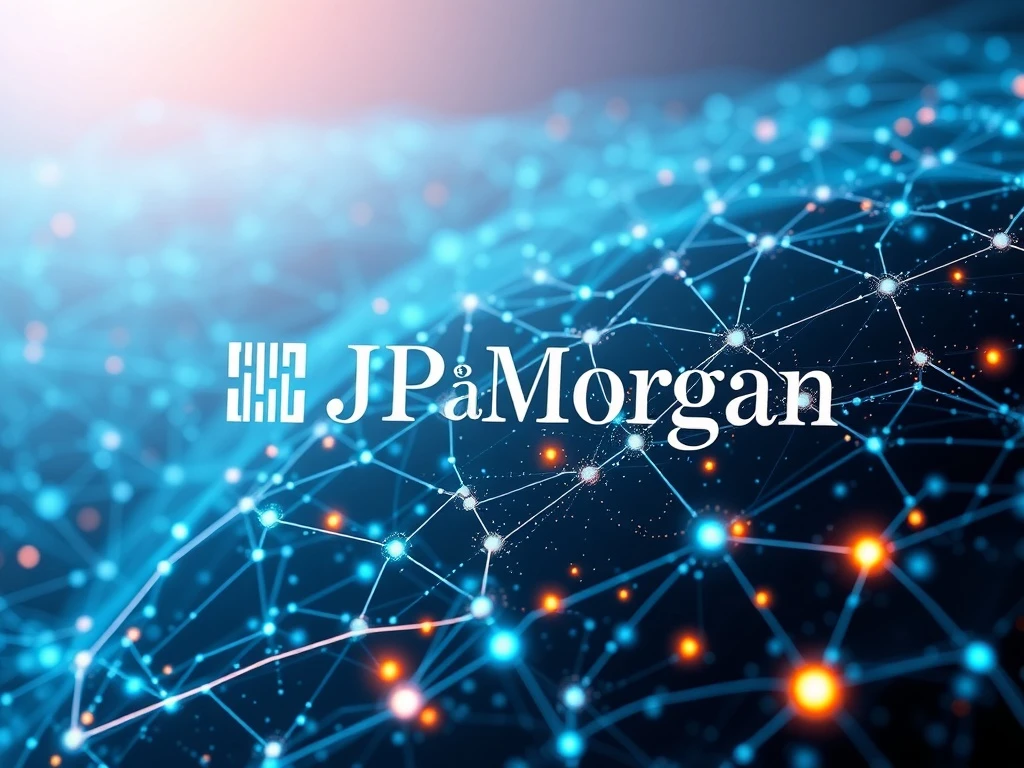JPMorgan’s Revolutionary Kinexys Fund Flow: A Bold Bet on Tokenization by 2026

The financial world stands at the precipice of a significant transformation, driven by innovative blockchain technology. Specifically, Wall Street giant JPMorgan is making a bold move into the future of finance. They are betting big on JPMorgan tokenization with their upcoming Kinexys Fund Flow platform. This development is crucial for anyone interested in the intersection of traditional finance and the evolving digital asset space.
JPMorgan Tokenization: Launching Kinexys Fund Flow
JPMorgan is actively advancing its fund tokenization platform, known as Kinexys Fund Flow. Reports indicate a planned rollout for this groundbreaking system in 2026. This initiative signals a clear strategic direction for the major U.S. investment bank. They have already tokenized a private-equity fund on their proprietary blockchain platform. This tokenized product is now accessible to their high-net-worth clients.
The Wall Street Journal recently reported on these plans. JPMorgan intends to tokenize a diverse range of assets. These include hedge funds, private credit, and real estate, all facilitated by Kinexys Fund Flow. Anton Pil, an executive from JPMorgan’s asset management arm, expressed confidence in this shift. He stated, “For the alternative investments industry, it’s just a matter of time that a blockchain-based solution is going to be adopted.” This statement underscores the bank’s belief in the inevitability of blockchain adoption within traditional financial services.
Understanding Asset Tokenization and its Benefits
Asset tokenization is a process that transforms ownership of real-world assets into digital tokens. These tokens reside on a blockchain. Real estate, commodities, and various types of funds can all undergo this digitization. Unlike conventional assets, tokenized versions offer enhanced flexibility. They enable features such as fractional ownership and use as collateral. This makes them significantly more versatile for investors.
Pil, who leads global alternative investment solutions at JPMorgan’s asset management arm, emphasized the core advantage. Tokenized assets provide a simpler entry point for investors. They gain exposure to various asset classes with greater ease. “It’s more about simplifying the ecosystem of alternatives,” he explained. “It makes it, frankly, a little easier to access for most investors.” This simplification addresses long-standing barriers in alternative investments.
Key benefits of asset tokenization include:
- Increased Liquidity: Tokenized assets can be traded more easily and frequently than their traditional counterparts.
- Fractional Ownership: Investors can own a small portion of a high-value asset, lowering entry barriers.
- Enhanced Transparency: Blockchain records all transactions, providing an immutable audit trail.
- Reduced Costs: Eliminating intermediaries can lower administrative and transaction fees.
- Global Accessibility: Digital tokens can be accessed and traded by investors worldwide, 24/7.
The Rise of RWA Tokenization and JPMorgan’s History
RWA tokenization, or real-world asset tokenization, has emerged as a dominant trend in recent years. Investment powerhouses like BlackRock foresee a future where nearly every financial asset is tokenized. JPMorgan has been a proactive participant in this space for some time. The banking giant has demonstrated significant activity in tokenization and blockchain-based financial infrastructure since approximately 2019.
That year marked the formal launch of its Onyx division. This division spearheaded various blockchain projects. In late 2024, the company rebranded Onyx to Kinexys. This rebranding underscored a renewed mission. Kinexys aims to accelerate the mainstream adoption of blockchain technology and tokenization within financial services. This strategic evolution highlights JPMorgan’s long-term commitment to digital assets.
Broader Implications for Blockchain Adoption
JPMorgan’s continued investment in Kinexys Fund Flow sends a powerful signal. It reinforces the growing conviction that blockchain technology will reshape global finance. The move from pilot programs to a full platform rollout in 2026 suggests a maturing ecosystem. This platform will likely attract more institutional players to the tokenization space. As more major banks embrace these technologies, the pace of blockchain adoption across the industry will undoubtedly increase.
This initiative could pave the way for a more interconnected and efficient financial system. Traditional assets will become more accessible and liquid. This benefits both institutional investors and, eventually, retail participants. The convergence of traditional finance with blockchain technology is no longer a distant concept. It is a present reality, with JPMorgan leading the charge. This evolution is set to redefine how we perceive and interact with financial assets.
The Future Landscape of Tokenized Finance
The anticipated broader rollout of Kinexys Fund Flow next year is a pivotal moment. JPMorgan expects to tokenize additional asset classes. These include private credit and real estate, further expanding the platform’s scope. This expansion demonstrates a clear vision for a future where digital ownership is standard. It promises greater efficiency and accessibility across various investment types.
The bank’s consistent efforts to integrate blockchain into its core operations reflect a long-term strategy. They are not merely experimenting; they are building foundational infrastructure. This commitment solidifies JPMorgan’s position as a leader in financial innovation. Their actions could inspire other major institutions to accelerate their own tokenization efforts. Ultimately, this will contribute to a more robust and digitally advanced global financial market.







